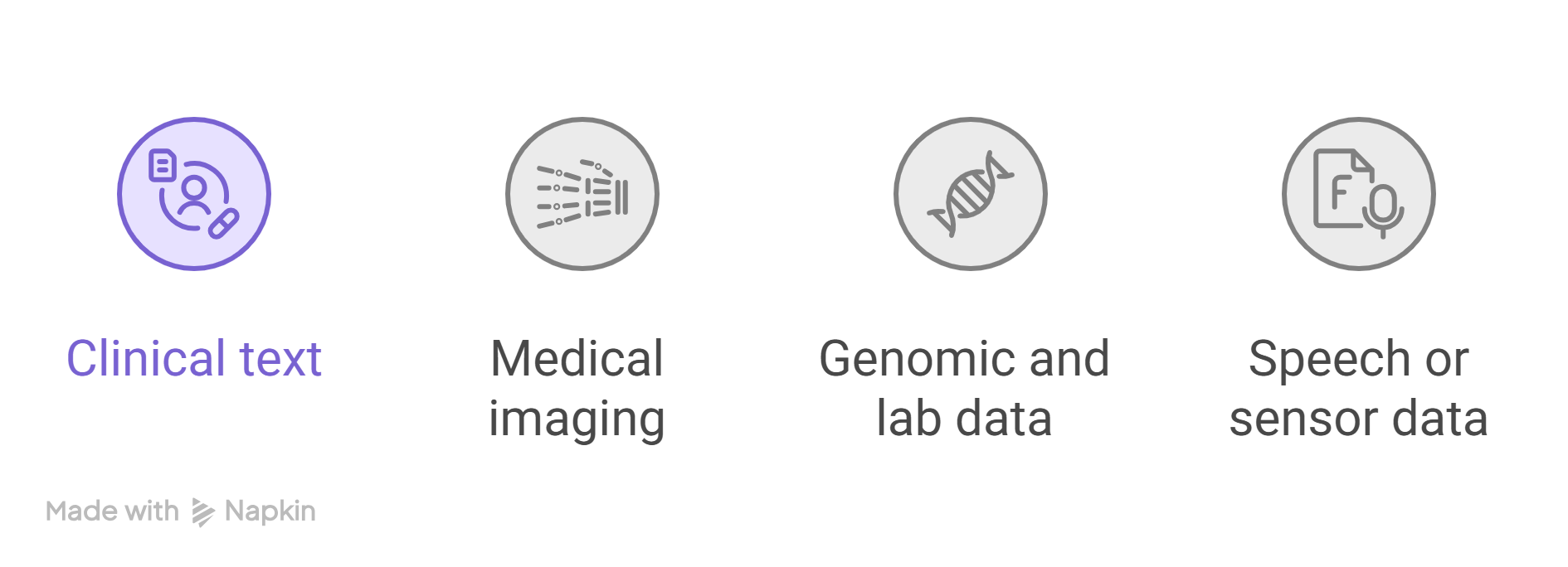Why are diagnostic errors a persistent challenge in healthcare?
Diagnostic errors affect nearly one in ten patients globally and are a leading cause of preventable harm. They stem from multiple factors: incomplete data, human fatigue, cognitive bias, and fragmented information across systems. Physicians must often interpret large volumes of heterogeneous data: imaging, lab results, clinical notes, under tight time constraints, which can lead to oversights.
Artificial intelligence (AI), particularly multimodal AI, is emerging as a powerful ally in reducing diagnostic errors. By integrating diverse data modalities, such as text, images, and structured lab data, AI systems can provide more accurate, context-rich insights to support clinical decision-making.
What is multimodal AI and how does it address diagnostic errors?
Multimodal AI combines and interprets data from multiple sources to produce comprehensive clinical insights. Traditional AI systems are typically trained on single modalities (e.g., imaging or text), limiting their diagnostic context. In contrast, multimodal models correlate imaging patterns with textual findings, lab values, and other sources of information despite its modality.
This integrated approach mitigates diagnostic blind spots by ensuring that AI considers the complete clinical picture, and not just one particular source of data. John Snow Labs’ Medical VLM-24B model, for example, supports explainable multimodal reasoning combining text with medical images.
Core modalities analyzed by multimodal AI:
- Clinical text: from physician notes, discharge summaries, and pathology reports.
- Medical imaging: radiographs, MRIs, CT scans, and histopathology slides.
- Genomic and lab data: structured data that provide quantitative biomarkers.
- Speech data: for example capturing conversations between patient and healthcare worker as in medical scribers.
- Sensor data: used for example in wearables or vital signs monitoring devices.
How does multimodal AI reduce diagnostic errors in practice?
- Enhanced Pattern Recognition: Multimodal models detect subtle correlations across modalities, for instance, linking an imaging anomaly with abnormal biomarkers or a clinician’s textual note.
- Improved Contextual Understanding: By combining textual and visual data, AI can differentiate between similar pathologies (e.g chronic obstructive pulmonary disease vs. chronic heart failure) with higher accuracy.
- Automated Cross-Validation: AI continuously cross-checks data across modalities to flag inconsistencies that could lead to diagnostic errors.
- Decision Support Alerts: AI models generate explainable alerts when discrepancies appear between reported findings and imaging results.
What are the key clinical applications of multimodal AI for error reduction?
- Radiology: AI identifies misinterpretations or overlooked findings by comparing imaging results with prior reports and notes.
- Oncology: Integration of pathology, genomics, and radiology data improves cancer subtype classification and treatment selection.
- Cardiology: Combining echocardiogram images, ECG data, and textual reports reduces misclassification of heart diseases.
In all these domains, multimodal AI serves as a second set of eyes, enhancing, not replacing, clinician expertise.
How does explainability enhance clinician trust in multimodal AI?
Explainability is essential to safe AI adoption. Clinicians must understand why an AI system suggests a specific diagnosis or flags a discrepancy. Multimodal models can visualize correlations, such as heatmaps linking regions of an image to keywords in a radiology report providing a more transparent rationale.
How does John Snow Labs enable multimodal AI for diagnostic safety?
John Snow Labs provides a comprehensive suite of tools that power explainable and compliant multimodal AI workflows:
- Healthcare NLP Pipelines extract and structure clinical insights from notes and EHRs.
- Medical VLM-24B integrates text and vision for contextualized diagnostic reasoning.
- Generative AI Lab allows clinicians and researchers to annotate, train, and validate multimodal data collaboratively, without coding.
- De-identification models ensure HIPAA and GDPR compliance for secure data sharing across modalities.
These solutions empower healthcare organizations to deploy multimodal diagnostic models that enhance accuracy while preserving transparency and safety.
What are the measurable impacts of multimodal AI on diagnostic performance?
Early deployments show that multimodal AI can:
- Reduce false negatives in radiology interpretation.
- Increase diagnostic agreement between clinicians and AI.
- Shorten time-to-diagnosis for complex cases.
- Decrease missed follow-ups and documentation errors through automated cross-checking.
What challenges must still be addressed?
Collaboration between AI developers, clinicians, and regulators is key to ensuring these tools are safe, effective, and trustworthy. Despite progress, multimodal AI faces some challenges:
- Data Silos and Standardization: Different modalities often exist in incompatible formats or systems.
- Bias and Representativeness: Training data must reflect population diversity to avoid inequitable outcomes.
- Model Validation: Continuous evaluation across real-world settings is needed for regulatory compliance.
- Interpretability: Balancing complexity with transparency remains a technical challenge.
Where is multimodal AI headed?
The next frontier is real-time, multimodal diagnostic assistance, AI systems that interpret imaging, text, and physiological signals simultaneously to support point-of-care decisions. Integrating multimodal AI into clinical workflows will enable personalized diagnostics, earlier interventions, and more consistent outcomes.
Some emerging trends include:
- Federated Multimodal Learning for privacy-preserving cross-institutional collaboration.
- Multimodal Foundation Models trained on billions of medical image-text pairs.
- Conversational Diagnostic AI that integrates natural language queries with image and lab interpretation.
FAQs
What is multimodal AI in diagnostics?
It’s an AI approach that integrates data from multiple sources (imaging, text, labs, signals, genomics… ) to deliver more accurate and context-aware diagnostic insights.
How does explainability impact adoption?
Transparent AI decisions foster clinician trust and facilitate regulatory approval.
Is multimodal AI compliant with healthcare regulations?
When built on HIPAA- and GDPR-compliant infrastructures, multimodal systems meet stringent privacy and auditability standards.
Conclusion
Reducing diagnostic errors requires both advanced analytics, human-centered design, and strict evaluation frameworks. Multimodal AI provides clinicians with a comprehensive, explainable view of patient data, minimizing oversights and improving clinical confidence. By combining text, imaging, and structured data into a unified view, healthcare organizations can make diagnostics more precise, equitable, and efficient.
John Snow Labs leads this transformation by delivering multimodal AI solutions as John Snow Labs’ Medical VLM-24B , helping healthcare move closer to error-free, data-driven diagnosis.






























